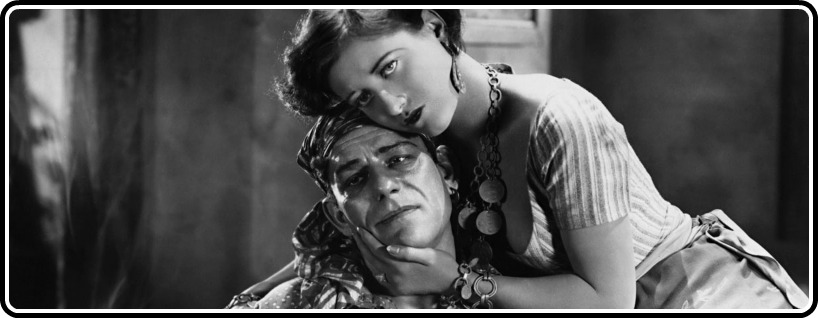When people hear the name Tod Browning, Bela Lugosi intoning “I am Dracula” instantly pops into mind. Inarguably best known for his legendary Universal classic Dracula, Browning has also become something of an icon in the cult horror world, particularly for his legendary pre-Code horror masterpiece, Freaks. However, there is one film that may rule them all, and it comes from a period of horror cinema not too well known by even the most accomplished cinephiles.
Just a handful of years prior to Browning’s release of Dracula, he and long time star Lon Chaney teamed up for what may be one of the best and most intense pictures either of them put their name onto.
Entitled The Unknown, the film stars Chaney as a man named Alonzo, an armless knife thrower and gun shooter for a circus outfit. Well, that’s at least how we meet him. While he seems on the surface to be an armless man he very much has all appendages, and is actually a burglar on the lamb. With his accomplice, Cojo, in tow, the pair strike out to lay low until the proverbial heat gets further from them.
Why is he playing an armless man you may wonder? Well, besides the abnormality on his left hand that would almost instantly give him up as the wanted criminal, he catches the eye of a young, beautiful performer named Nanon (Joan Crawford), a woman who is nearly sent into sickness at the touch of another man, the “strong man” Malabar (Norman Kerry). Now, while this doesn’t sound like the tale woven by a definitive silent horror classic, an eye turning performance from Chaney and some of Browning’s most atmospheric and brooding direction changes this picture from crime drama to a genuinely thrilling bit of silent horror cinema.
First paired together for the 1919 melodrama The Wicked Darling, Chaney and Browning are a real cinematic match made in heaven. The man of a million faces and the stylistic filmmaker behind films like The Unholy Three made a cavalcade of pictures together, all of which melded the dark brood of Browning’s aesthetic and the striking level of depth Chaney gave to his characters. None of their collaborations prove as memorable as this picture, however.
Browning is this film’s biggest star, proving that a lackluster, style-free picture like Dracula (save for the stunning and seemingly out-of-a-different-picture sequences set near the titular lead’s collection of coffins, the film’s most style-filled sequences) is more the exception than the rule. Percussive set pieces abound here, particularly in the film’s final act, which includes one of the more tense sequences in all of silent horror cinema. The sequence, the attempted murder of the previously mentioned strong man during one of his performances, is so deeply troubling and breathlessly crafted that it is a real stand out sequence of the genre from this time period. There is a smoke-filled haze to the picture’s photography, and the murky circus setting is just one of the many precursors to Browning’s crowning achievement, the masterpiece known as Freaks.
And yet, Chaney steals every moment of the film. One of his most deliciously sneering performances, the actor not only had a face for this type of role aesthetically, but had as great a silent film face as there ever truly was. Impressively expressive and with enough realism shown on that mug of his to make any filmgoer believe he may very well be a mad criminal on the run, Chaney is absolutely fantastic here, turning it what is very much a definitive turn not only for the actor, but for silent horror cinema in general. And then there is Crawford. A young and breathtakingly gorgeous Joan Crawford co-stars here as the film’s main love interest, and is really quite solid. It’s not an intensely deep performance (but again, neither is Chaney, if we’re not going to mince words here), but it’s an engaging turn, and her innocence really amps up the film’s final few moments. It’s a deeply troubling film, and it is in her face that much of the real terror is felt.
Now, the film only clocks in around 50 minutes, and it’s a rather tough picture to really hunt down. Occasionally thrown in in various Lon Chaney box sets, the film was once thought to have been lost until the film was found once again in the late ‘60s. Some sequences are still lost to time, but as seen in this Vimeo-friendly version, the film’s actual narrative is still perfectly intact. The print that you can stream on Vimeo features come John Carpenter-esque title cards and a score to absolutely die for (along with a relatively gorgeous transfer) so it very much screams of a new DVD/Blu-ray release.
But what about the supplements? The film has become something of a darling among the arthouse horror set, particularly those with a penchant for horror pictures with as much atmosphere as they have action. Often seen near the top of anyone’s greatest silent horror films list, there would be writers lining up to pen a booklet for Criterion, and I’m sure a name like David Kalat or Gregory Mank could get behind a commentary or video essay. Grab an interview with David Skal and you’ll have a release that would have cinephiles and horror hounds alike chomping at the bit to get their hands on this picture. It’s the release this film truly deserves.




![Bergman Island (The Criterion Collection) [Blu-ray]](https://criterioncast.com/wp-content/uploads/2022/11/bergman-island-the-criterion-collection-blu-ray-400x496.jpg)
![This Is Not a Burial, It’s a Resurrection (The Criterion Collection) [Blu-ray]](https://criterioncast.com/wp-content/uploads/2022/11/this-is-not-a-burial-its-a-resurrection-the-criterion-collection-blu-ray-400x496.jpg)
![Lars von Trier's Europe Trilogy (The Criterion Collection) [The Element of Crime/Epidemic/Europa] [Blu-ray]](https://criterioncast.com/wp-content/uploads/2022/11/lars-von-triers-europe-trilogy-the-criterion-collection-the-element-of-400x496.jpg)
![Imitation of Life (The Criterion Collection) [Blu-ray]](https://criterioncast.com/wp-content/uploads/2022/11/imitation-of-life-the-criterion-collection-blu-ray-400x496.jpg)
![The Adventures of Baron Munchausen (The Criterion Collection) [4K UHD]](https://criterioncast.com/wp-content/uploads/2022/11/the-adventures-of-baron-munchausen-the-criterion-collection-4k-uhd-400x496.jpg)
![Cooley High [Criterion Collection] [Blu-ray] [1975]](https://criterioncast.com/wp-content/uploads/2022/11/cooley-high-criterion-collection-blu-ray-1975-400x496.jpg)